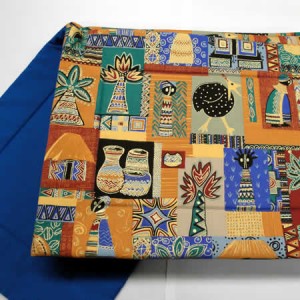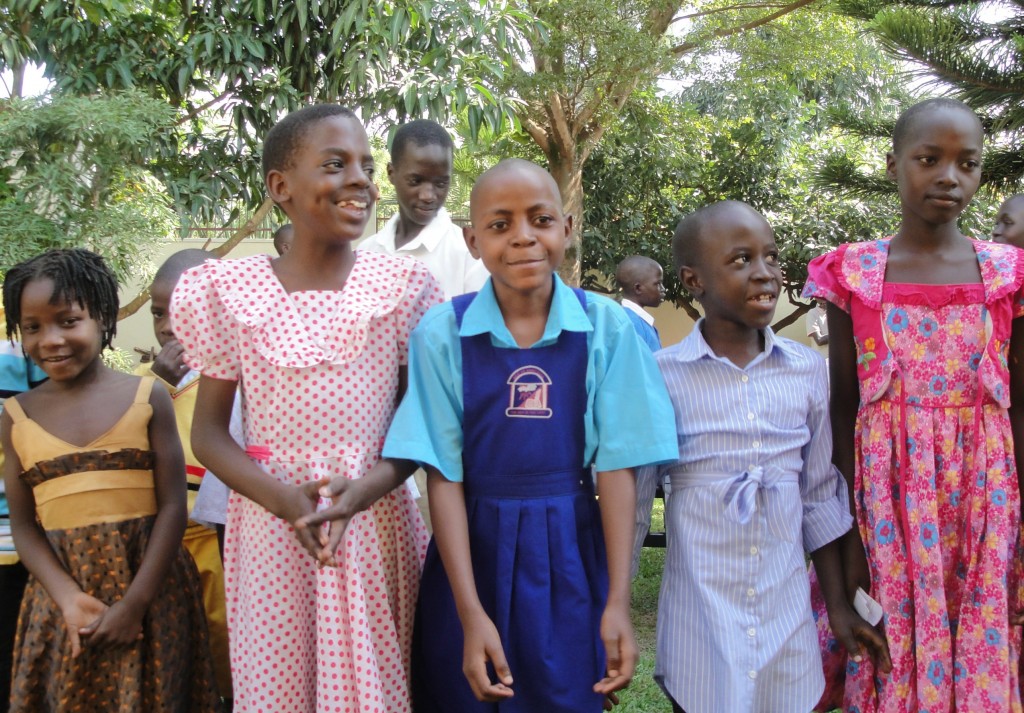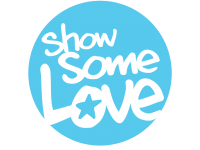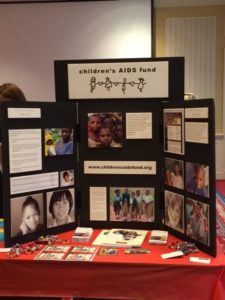news
Be a Guardian Angel in 2016
 The 6th child in a family of 10 children, there was no money for Lucy to pay the required fees to attend school. Wanting to help, a compassionate aunt brought Lucy from her rural village to the city. The idea was that there Lucy could find work as a maid and raise money for her education.
The 6th child in a family of 10 children, there was no money for Lucy to pay the required fees to attend school. Wanting to help, a compassionate aunt brought Lucy from her rural village to the city. The idea was that there Lucy could find work as a maid and raise money for her education.
Lucy’s aunt—a widow who lost her husband to HIV/AIDS a decade ago—understands what it is to lack opportunities and support. She was left to raise her five orphaned children and has struggled to provide for even them.
After about a year in the city without success funding even little jobs to raise modest funds for school, Lucy met CAFI partner Destiny Friends International (DEFI). A small organization itself founded and staffed by HIV-impacted individuals, DEFI’s identifies vulnerable children like Lucy to assist through their after-school and Saturday children’s clubs.
. . .because people like YOU decided to become Guardian Angels for these . . . very vulnerable children, Lucy has just completed her first year at school.
Through local volunteers, DEFI raised enough money to send Lucy to school for one semester. Then, CAFI learned about Lucy. And because people like YOU decided to become Guardian Angels for these precious and very vulnerable children, Lucy has just completed her first year at school.
Lucy is just one of millions of HIV-impacted children around the world who need Guardian Angels.
This Holiday Season YOU can join CAFI’s growing band of Guardian Angels by providing an education for Lucy and so many other young girls like her to equip them to live healthy, hopeful lives.
Looking for Unique and Significant Holiday Gifts?
 Browse the wide array of gifts for your consideration at the CAFI online store. Any gift you purchase will provide critical and tangible support for HIV-impacted children and their families.
Browse the wide array of gifts for your consideration at the CAFI online store. Any gift you purchase will provide critical and tangible support for HIV-impacted children and their families.
Hand crafts made by HIV-impacted women:
Paper Beads
Placemats, Table runners and Table Cloths
Book Marks
Gifts of education and empowerment:
School Uniforms and Supplies
School fees for HIV-impacted children
Vocational training for vulnerable girls
Prevention education for youth
Specialized professional training and mentorship
Thank you for giving purposeful gifts of health, hope and happiness this holiday season!
Gifts of microenterprise and nutrition support:
Pigs, chickens, goats to sell and provide food security
Seedlings for small family farmers
Gifts of medical care and treatment:
Treatment for non-HIV health needs
Dental care
Eye exams and glasses
As you shop, please contact us with any questions. Any gift you purchase will generate a card from CAFI to be given by you or sent directly to your recipient by CAFI.
Thank you for giving purposeful gifts of health, hope and happiness this holiday season!
Why Should We Recognize World AIDS Day?
 You may or may not know that today is World AIDS Day. And even if you do, you may wonder why we’re still talking about AIDS. There’s a great reason.
You may or may not know that today is World AIDS Day. And even if you do, you may wonder why we’re still talking about AIDS. There’s a great reason.
We have made amazing progress in mitigating the pandemic:
· More than 11.5 million people are receiving life-saving anti-retroviral therapy (ART)
· More than 11.7 million men have undergone voluntary medical circumcision to reduce the risk of HIV transmission
· Nearly 2 million babies have been born HIV free who otherwise would have been infected
· 1.1 million children are receiving life-saving ART—a 97% increase since 2014
· More than 1 million adolescent girls and young women have received critical prevention interventions
· 6.2 million orphans and vulnerable children have received care and support
· 74.3 million people have received HIV testing and counseling
But the job is not done! This progress is both amazing and critical to ending the HIV pandemic. Yet, certain populations are still at very high risk.
Girls ages 15 to 24 are among the highest risk. According to the latest UNAIDS report, young women face a triple threat. They are at high risk of HIV infection, have low rates of HIV testing, and have poor adherence to treatment.
· Every day, more than 1,000 adolescent girls and young women are infected
with HIV
· Girls account for 75% of new HIV infections among adolescents in sub-Saharan Africa
· Girls who experience violence are up to three times more likely to be infected with HIV
But the job is not done! This progress is both amazing and critical to ending the HIV pandemic. Yet, certain populations are still at very high risk.
Many factors make girls and young women particularly vulnerable, including gender-based violence, exclusion from economic opportunities, and a lack of access to secondary school. Ninety-eight million girls around the world are not in school, yet we know that a girl who has a basic education is three times less likely to contract HIV.
Experts agree that keeping girls in school will reduce their risk. Your gift of $50 or any other amount can ensure that she will stay in school and, thus, reduce her risk for HIV/AIDS.
Your gift today will help keep adolescent girls in school and protect them from HIV.
https://childrensaidsfund.org/store/products/
YOU Have Accomplished Amazing Things!
 During this special season of giving thanks, the Children’s AIDS Fund International wants to THANK YOU for giving health and hope to more than a million HIV impacted children around the world!
During this special season of giving thanks, the Children’s AIDS Fund International wants to THANK YOU for giving health and hope to more than a million HIV impacted children around the world!
One young Ugandan teen expressed how much YOU mean to him:
“Just like the sun does shine in my life, it may not seem enough to compare with you. You are the sky which keeps watching me over day and night. . . .You took me out of the dark and gave me a hand in the time I had no hope and you kept showing me the path. I would build you a mountain just to say “thanks”, but it is impossible. . . . I hope you may live just as long as a tortoise just to extend your kind and loving heart to others [like me] in need.”
YOU have changed the lives of these precious children—one child at a time—by providing medicine, dental care, psychosocial support, school fees and scholastic materials, vocational training, art and sports education, teen support groups, life skills education.
YOU have helped limit the suffering of more than a million HIV impacted children worldwide through your compassionate, selfless acts.
Additionally, YOU have provided parents and guardians with nutrition education; community gardens; income generating programs like fish ponds, pig and poultry raising, which all enable parents and guardians to better provide for and feed their children.
YOU have done this in many ways: family, neighborhood and community yard sales; birthday parties featuring HIV-impacted children; small businesses designating one-day’s proceeds; corporate grants; children saving their allowances; volunteering time and expertise. No matter the gift of time, talent or funds, the result is the same. YOU have helped limit the suffering of HIV impacted children through your compassionate, selfless acts.
THANK YOU for helping their futures be more secure, healthy and hopeful. . . .and in so doing THANK YOU for helping change the world.
2016 Combined Federal Campaign Launched
 The Combined Federal Campaign (CFC) is a 55-year Federal workplace giving tradition that has raised more than $8 billion for charitable organizations, making it one of the largest workplace giving campaigns globally. Funds raised each fall through the CFC help neighbors in need around the corner, across the nation and throughout the world. Under the theme “Show some Love”, this year’s campaign runs until December 15, 2016
The Combined Federal Campaign (CFC) is a 55-year Federal workplace giving tradition that has raised more than $8 billion for charitable organizations, making it one of the largest workplace giving campaigns globally. Funds raised each fall through the CFC help neighbors in need around the corner, across the nation and throughout the world. Under the theme “Show some Love”, this year’s campaign runs until December 15, 2016
This is one of the most important charity campaigns for CAFI
The CFC of the National Capital Area (CFCNCA) is the local campaign for federal employees in the Washington Metropolitan Area. It is one of the most important charity campaigns for CAFI with the nation’s capital so close to CAFI offices. More than $46 million was raised during the 2015 campaign. 
CAFI has participated in the CFC for over 18 years; raising hundreds of thousands of dollars for HIV impacted children and families. If anyone you know works in the federal government or is a member of the military, please let them know about CAFI’s important work to help limit the suffering of children and families affected by HIV. Ask them to visit our website, read about programs which benefit thousands of children and families, and ask them to designate CAFI as their beneficiary in the CFC.
Thanks very much for your help
State Employee Charity Giving Campaigns Begin
 Fall heralds the beginning of 2016 State Employee giving campaigns. Similar to the Combined Federal Campaign run by the US government, State campaigns ask employees to donate to one or more organizations on their list of approved charities. Approved organizations are selected based on a variety of program and finance criteria that varies from state to state.
Fall heralds the beginning of 2016 State Employee giving campaigns. Similar to the Combined Federal Campaign run by the US government, State campaigns ask employees to donate to one or more organizations on their list of approved charities. Approved organizations are selected based on a variety of program and finance criteria that varies from state to state.
This year the Children’s AIDS Fund International (CAFI) is participating in 17 state campaigns, which are an important source of funding for CAFI. Last year the Commonwealth of Virginia Campaign (CVC) lead the way with over $1,700 pledged. Thank you Virginia!
We try to attend as many state campaign kick-off events as possible to showcase CAFI’s important outcomes, but with campaign events in multiple states that can be difficult, if not impossible.
If you know anyone who works in one of these state governments, state universities or state run hospitals, let them know about the important work CAFI
This is where CAFI’s friends and supporters come in. Anyone who has colleagues or acquaintances living in and working for the State government in any of the following states can encourage them to consider donating to CAFI in their state campaign.
CAFI participates in the following state campaigns:
| State | Campaign Begins | Campaign Ends |
| Arizona | October 4 | November 30 |
| California | August 30 | October 31 |
| Connecticut | September 6 | December 9 |
| Florida | September 1 | November 10 |
| Georgia | September 1 | November 15 |
| Illinois | September 7 | November 2 |
| Maryland | September 12 | December 16 |
| Massachusetts | Early fall | Late fall |
| Michigan | September 12 | October 14 |
| New Jersey | September 8 | December 31 |
| New York | September | December |
| North Carolina | August 19 | December |
| Ohio | August 31 | October 14 |
| Pennsylvania | September 6 | October 28 |
| Rhode Island | October | December |
| Virginia | October 5 | December 31 |
| Washington (state) | October 1 | December 31 |
| Wisconsin | October 12 | November 30 |
If you know anyone who works in one of these state governments, state universities or state run hospitals, let them know about the important work CAFI is doing to help limit the suffering of children and families affected by HIV. Tell them about our website and the information it contains, or better yet forward them one of our emails highlighting our work.
Many thanks for your help and support!
A Tribute to HIV+ Mothers
 They say men build houses. But a house is not a home. Women build homes.
They say men build houses. But a house is not a home. Women build homes.
I come from a country where 3 in every 5 homes are headed by a woman who has to play a mother and father figure all her life. Growing up I wasn’t any different. Let me share what makes my mum worth celebrating this day.
Memories are still fresh when she started a pancake and cassava chips business which barely lasted a month. So weak and sick she would cry in pain all night yet wake up 5 am–as we children still enjoyed our sleep–to go buy tomatoes, onions and mukene (fish) which she sold on the veranda. But nobody cared to buy because nobody wanted to come close to a woman rumored to be HIV positive. Soon it was all rotten. Still she never gave up.
I recall the day she was sick but left us in the house, braved the rain and walked a long distance just to borrow a little money from a friend so we wouldn’t starve another day. She returned soaked wet with no money in her hands. But at least she tried. We slept hungry.
Let me share what makes my mum worth celebrating this day.
I watched as people disrespected her and threw insults at her in our face and we sat so defenseless because we had no man to stand in the gap and raise his voice but still with her we felt a sense of protection. Not once, not twice she took the blame for our wrong doings and even with the little strength she had she made sure she never lost her obligation in being a mother and father.
I often sat down and wondered how we got there. What happened to our commuter taxis? What happened to the over 20 people we hosted in our house in a month? What happened to the people that took pride in us calling them aunty but now shied away or cautioned us not to?
It is now that I appreciate the woman that saved up two months just to have transport to come visit me with no pocket money, the woman that got us all we wanted when she got her life back in place, the woman that believed in all I ever wanted to do and be and supported me in the dreams I had even when nobody saw them coming, the woman that still called me son when the whole world judged me by my attitude and way of life, the woman that came from her death bed to travelling the world giving hope to those on their death beds.
I’m proud I was raised by you, Mum, you deserve to be celebrated.
A Tribute to HIV+ Mothers
 Living with HIV/AIDS is a journey started by many kids knowingly or unknowingly. To some, it was mythical truth they realized later to be real. Mine started unknowingly. At the age of 11, the truth was uncoated for me to taste its bitterness, it felt like the world came crippling down on my head. Being HIV positive at that age was the last thing I ever thought of. I hated and blamed everything and everyone I could; lived indoors in a community that made life more complicated by pointing fingers, the ones who could have given me counsel at school–my teachers–always lit fire on me by calling me names which other children adopted.
Living with HIV/AIDS is a journey started by many kids knowingly or unknowingly. To some, it was mythical truth they realized later to be real. Mine started unknowingly. At the age of 11, the truth was uncoated for me to taste its bitterness, it felt like the world came crippling down on my head. Being HIV positive at that age was the last thing I ever thought of. I hated and blamed everything and everyone I could; lived indoors in a community that made life more complicated by pointing fingers, the ones who could have given me counsel at school–my teachers–always lit fire on me by calling me names which other children adopted.
You fought hard in changing schools for me so I could find comfort. Even when friends felt I was worthless, you helped me hold my head up and fight the challenge of living with HIV/AIDS; educated me that the world saw to live longer as hopeless, you showed and taught me the real meaning of love and life; life with a purpose.
You forewent your experience with HIV and became my first and best counselor ever, my guide and dear friend. You gave the whole of yourself to me; I am because you showed me the Way; Christ Jesus who has become a close friend, my hope of glory.
You single handedly raised me into the man that I have grown to be, full of hope and life. May you live to see me at your age today. I love you mama. You are the best!!! Happy mama’s day!!!
Mum, you always said our case was/is with God and he will pass the judgment in our favor since we are innocent; I did not understand then, but now I do understand. I can freely say “I was blind, but now see; I was dead but now I am alive!” You single handedly raised me into the man that I have grown to be, full of hope and life. May you live to see me at your age today. I love you mama. You are the best!!! Happy mama’s day!!!
Mother’s Day
I am what I am not because I was what I am.
It is a journey many have not succeeded to complete
It took love, dedication and a lot of sacrifices to reach me here
My well-being and happiness were birthed from her tiring & sweat
Some had to forego luxury and pride to see me smile
Shielded me from the bitter reality of life and prepared me for it
She spent sleepless nights when I was ill
Swallowed the pain to see me smile,
Happy Mother’s day.
Dispelling Myths About HIV/AIDS

Myth # 2 – HIV/AIDS is Not an Issue in the United States
In the course of the HIV/AIDS pandemic, we in the United States have been very fortunate to have a government that made HIV/AIDS a primary focus in the epidemic’s early days; relatively easy access to great health care; and widespread availability of each new generation of HIV treatment. Unlike many nations where HIV transmission went virtually unchecked for the pandemic’s first decade or more, the US has been spared the high rates of infection, staggering numbers of deaths, and exploding number of children orphaned by HIV that have been recorded around the globe.
Unfortunately this has led many Americans to believe that HIV/AIDS is not an issue in the US. That is not the case. Consider the following:
– More than 1.2 million people in the US are living with HIV infection.
– Nearly 1 in 8 (12.8%) of HIV infected Americans are unaware of their infection.
– Over the past decade, the number of people living with HIV has increased.
– The estimated number of new HIV infections has remained stable in recent years at about 50,000 new infections annually.
– Although men who have sex with men represent about 4% of the US male population, they accounted for 78% of new HIV infections among men and 63% of all new infections.
– New HIV infections among women are primarily attributed to heterosexual contact (84% in 2010) or injection drug use (16% in 2010).
– African Americans represent approximately 12% of the US population, but accounted for 44% of new HIV infections in 2010.
– Hispanic/Latinos represented 16% of the US population but accounted for 21% of new HIV infections i
– About 1 in 4 new infections in the US is among youth ages 13-24. Most do not know they are infected, are not getting treated, and can unknowingly pass the virus on to others.
Lest we Americans become too complacent about this very real HIV issue within our borders, consider that some of our urban areas have HIV rates that exceed some African nations.
It is long past time for Americans to acknowledge that we have not done as well at ending our own HIV/AIDS epidemic as many other nations around the globe. Next time your hear someone repeat the myth that there is not HIV/AIDS issue in the US, please explain the real facts.
Source: CDC: US Statistics: HIV in the United States
Dispelling Myths about HIV/AIDS

Myth # 1 – The HIV/AIDS Pandemic is Under Control & Going Away
Many believe that the incredible investment of funds to fight HIV/AIDS and the great strides have been made in effective HIV/AIDS treatment mean the pandemic is under control and waning. After more than 30 years HIV/AIDS is rarely in the news, which also leads to the perception that it is no longer an issue.
While it is true that much progress has been made in the global fight against the pandemic, reality is there is much more to be done before we’ve won the war.
– Consider the following:
– Every week, nearly 35,000 people are infected with HIV globally:
– Young people ages 15-24 account for about 30% of new infections.
– In sub-Saharan Africa young women account for 63% of young people living with HIV.
– In 2014, there were 220,000 new infections among children.
– While HIV incidence has declined by 50% since its peak in sub-Saharan Africa, the region’s population has increased by 340 million during the same time period. Africa has the world’s youngest population with 200 million people between ages 15 and 24—a time when they are most susceptible to HIV infection.
– New HIV infections globally have declined by 35% since 2000. In 61 countries new HIV infections have decreased more than 20%. Still, there were 2 million new infections in 2015, or about 5,600 new infections per day.
– Although HIV testing capacity has increased over time allowing more people to learn their status, nearly half of all people with HIV are still unaware they are infected.
– Globally 30 countries account for more than 80% of the world’s new HIV infections.
In 2014, UNAIDS data showed the world a five-year window (2015 – 2020) to accomplish a fast-track response which would change the pandemic’s course. If we succeed, the world will be on track to end HIV infections by 2030. If we don’t, HIV infections will continue to rise to previous levels; the opportunity to end HIV infections lost.
We do have the change to end HIV infections globally, that has not happened yet. We must all continue to be vigilant and engaged if we hope to see an HIV-free generation become reality in our lifetimes.
Sources: PEPFAR 2016 Annual Report to Congress; UNAIDS Fast Track: Ending the AIDS Epidemic by 2030; The Henry Kaiser Family Foundation November 2015 Fact Sheet: The Global HIV/AIDS Epidemic


